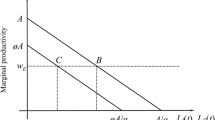Abstract
The monopoly union model and the wage bargaining model are analysed in light of the distinction between insiders and outsiders. It is shown that a possible outcome of the wage bargaining is the wage level where all insiders keep their job, but no outsiders are taken on. In this situation, small variations in the bargaining situation of the union will not affect the wage and employment outcome. Furthermore, it may even be the case that the union does not wish a higher wage, because this would lead to lay-offs among the insiders. Thus, the monopoly union model and the bargaining model may yield the same wage and employment levels.
Similar content being viewed by others
References
Barker, A.; Lewis, P.; and McCann, M. (1984): “Trade Unions and the Organisation of the Unemployed.”British Journal of Industrial Relations 22: 391–404.
Binmore, K. G.; Rubinstein, A.; and Wolinsky, A. (1986): “The Nash Bargaining Solution in Economic Modelling.”Rand Journal of Economics 17: 176–188.
Blanchard, O., and Summers, L. (1986): “Hysteresis and the European Unemployment Problem.”NBER Macroeconomics Annual I: 15–78.
Carruth, A. A., and Oswald, A. J. (1987): “On Union Preferences and Labour Market Models: Insiders and Outsiders.”Economic Journal 97: 431–445.
Dunlop, J. T. (1944):Wage Determination under Trade Unionism. New York: Macmillan.
Holden, S. (1989): “Wage Drift and Bargaining: Evidence from Norway.”Economica 56: 419–432.
Lindbeck, A., and Snower, D. (1988): “Cooperation, Harassment, and Involuntary Unemployment: An Insider-Outsider Approach.”American Economic Review 78: 167–188.
Manning, A. (1987): “An Integration of Trade Union Models in a Sequential Bargaining Framework.”Economic Journal 97: 121–139.
McConnell, S. (1989): “Sales, Bargaining Costs and the Real Wage.” Working Paper 1110. Centre for Labour Economics, LSE.
McDonald, I. M., and Solow, R. M. (1981): “Wage Bargaining and Employment.”American Economic Review 71: 896–908.
Nickell, S. J. (1982): “The Modelling of Wages and Employment.” InEconometrics and Quantitative Economics, edited by D. F. Hendry and K. F. Wallis. Oxford: Blackwell.
Oswald, A. J. (1984): “Efficient Contracts are on the Labour Demand Curve: Theory and Facts.” Working Paper 178. Industrial Relations Section, Princeton University.
Pemberton, J. (1988): “A Managerial Model of the Trade Union.”Economic Jorunal 98: 755–771.
Solow, R. (1985): “Insiders and Outsiders in Wage Determination.”Scanddinavian Journal of Economics 87: 411–428.
Svejnar, J. (1986): “Bargaining Power, Fear of Disagreement and Wage Settlements: Theory and Evidence from U. S. Industry.”Econometrica 54: 1055–1078.
Author information
Authors and Affiliations
Additional information
This paper is part of the research project “Wage Formation and Unemployment” at SAF Center for Applied Research at the Department of Economics, University of Oslo. Comments from Michael Hoel, Andrew Oswald, Åsa Rosén, Asbjørn Rødseth and an anonymous referee on earlier drafts are gratefully acknowledged.
Rights and permissions
About this article
Cite this article
Holden, S. Insiders and outsiders in labour market models. Zeitschr. f. Nationalökonomie 52, 43–54 (1990). https://doi.org/10.1007/BF01227501
Received:
Revised:
Issue Date:
DOI: https://doi.org/10.1007/BF01227501




